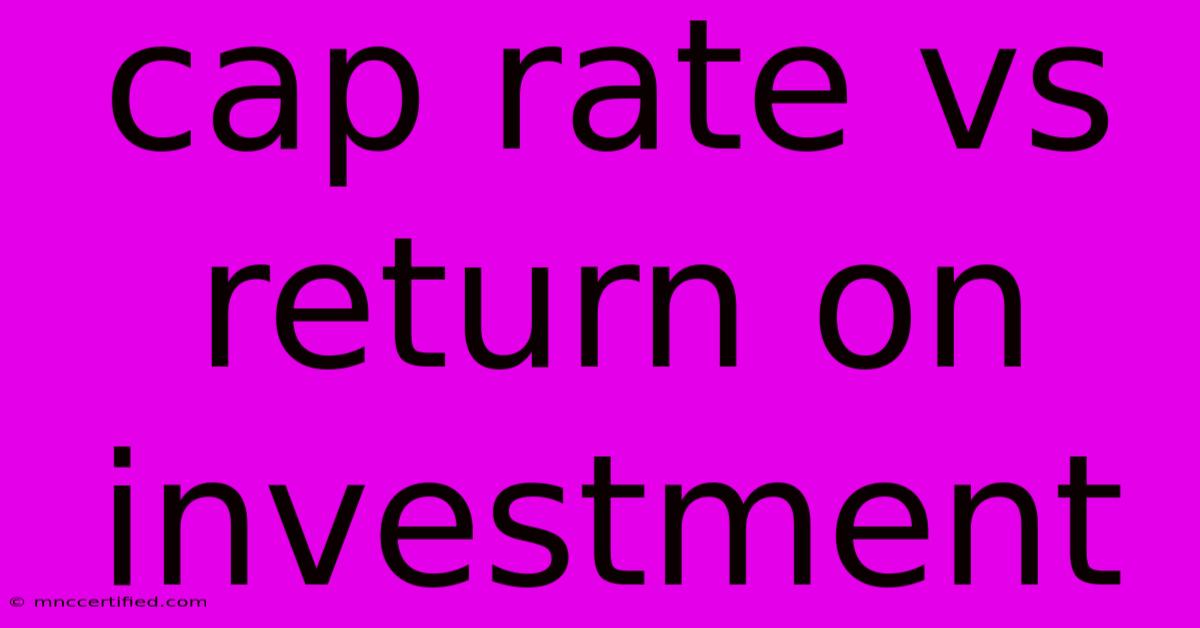Cap Rate Vs Return On Investment

Table of Contents
Cap Rate vs. ROI: Understanding Key Real Estate Investment Metrics
Choosing the right real estate investment requires careful analysis. Two crucial metrics often compared are the capitalization rate (cap rate) and the return on investment (ROI). While both measure profitability, they offer different perspectives and shouldn't be used interchangeably. Understanding their nuances is vital for making informed decisions.
What is Cap Rate?
The capitalization rate, or cap rate, is a quick measure of a property's potential income relative to its value. It essentially shows the potential rate of return on a real estate investment based solely on the property's net operating income (NOI).
Formula: Cap Rate = (Net Operating Income / Property Value) x 100
-
Net Operating Income (NOI): This is the property's annual rental income minus operating expenses (excluding mortgage payments, debt service, and depreciation). Calculating NOI accurately is crucial for an accurate cap rate.
-
Property Value: This is the current market value of the property. Obtaining an accurate valuation requires professional appraisal or careful market research.
Example: A property with an NOI of $50,000 and a market value of $500,000 has a cap rate of 10% ($50,000 / $500,000 = 0.10).
Key takeaway: A higher cap rate generally indicates a potentially more lucrative investment, assuming all other factors are equal. However, it's crucial to remember that cap rate only considers income and property value, ignoring financing and other crucial factors.
What is ROI?
Return on investment (ROI) is a broader measure of profitability that considers the total return relative to the total investment. It accounts for all costs associated with the investment, including the purchase price, closing costs, renovations, and even financing costs.
Formula: ROI = [(Gain from Investment - Cost of Investment) / Cost of Investment] x 100
-
Gain from Investment: This includes net income (NOI) plus any appreciation in the property value during the ownership period.
-
Cost of Investment: This encompasses all expenses associated with acquiring and maintaining the property.
Example: If you purchase a property for $500,000, invest $50,000 in renovations, and sell it for $650,000 after earning $50,000 in rental income over the ownership period, your ROI would be: [($650,000 + $50,000 - $500,000 - $50,000) / ($500,000 + $50,000)] x 100 = 20%.
Key takeaway: ROI provides a more comprehensive picture of profitability than cap rate because it accounts for all expenses, including financing costs and potential appreciation. It's a better metric for assessing overall investment success.
Cap Rate vs. ROI: Key Differences
| Feature | Cap Rate | ROI |
|---|---|---|
| Focus | Income relative to property value | Total return relative to total investment |
| Financing | Ignores financing costs | Includes financing costs |
| Time Horizon | Snapshot of current income potential | Considers returns over the entire investment period |
| Appreciation | Ignores property value appreciation | Includes property value appreciation |
| Complexity | Simpler to calculate | More complex to calculate |
Which Metric Should You Use?
Both cap rate and ROI are valuable tools, but their application depends on the context:
-
Cap Rate: Ideal for comparing similar properties with similar financing structures. It's useful for quick comparisons and initial screening of potential investments. It helps in understanding the current income-generating potential.
-
ROI: Better for evaluating the overall profitability of an investment considering all costs and potential appreciation over time. It provides a more complete picture of long-term investment performance.
In conclusion, using both cap rate and ROI offers a well-rounded perspective on a real estate investment's potential profitability. Don't rely solely on one metric; use both to make informed, data-driven decisions that align with your investment goals. Remember to consult with real estate professionals and financial advisors for personalized guidance.

Thank you for visiting our website wich cover about Cap Rate Vs Return On Investment. We hope the information provided has been useful to you. Feel free to contact us if you have any questions or need further assistance. See you next time and dont miss to bookmark.
Featured Posts
-
Plymouth Boss Rooney Enjoying Life Away From Coleen
Nov 22, 2024
-
Wagner Scores 37 Clutch 3 Pointer Wins
Nov 22, 2024
-
Gaetz Quits Attorney General Race
Nov 22, 2024
-
Thursday Night Football Steelers Browns Preview
Nov 22, 2024
-
Wicks Heartbreak His Split With Higgins
Nov 22, 2024